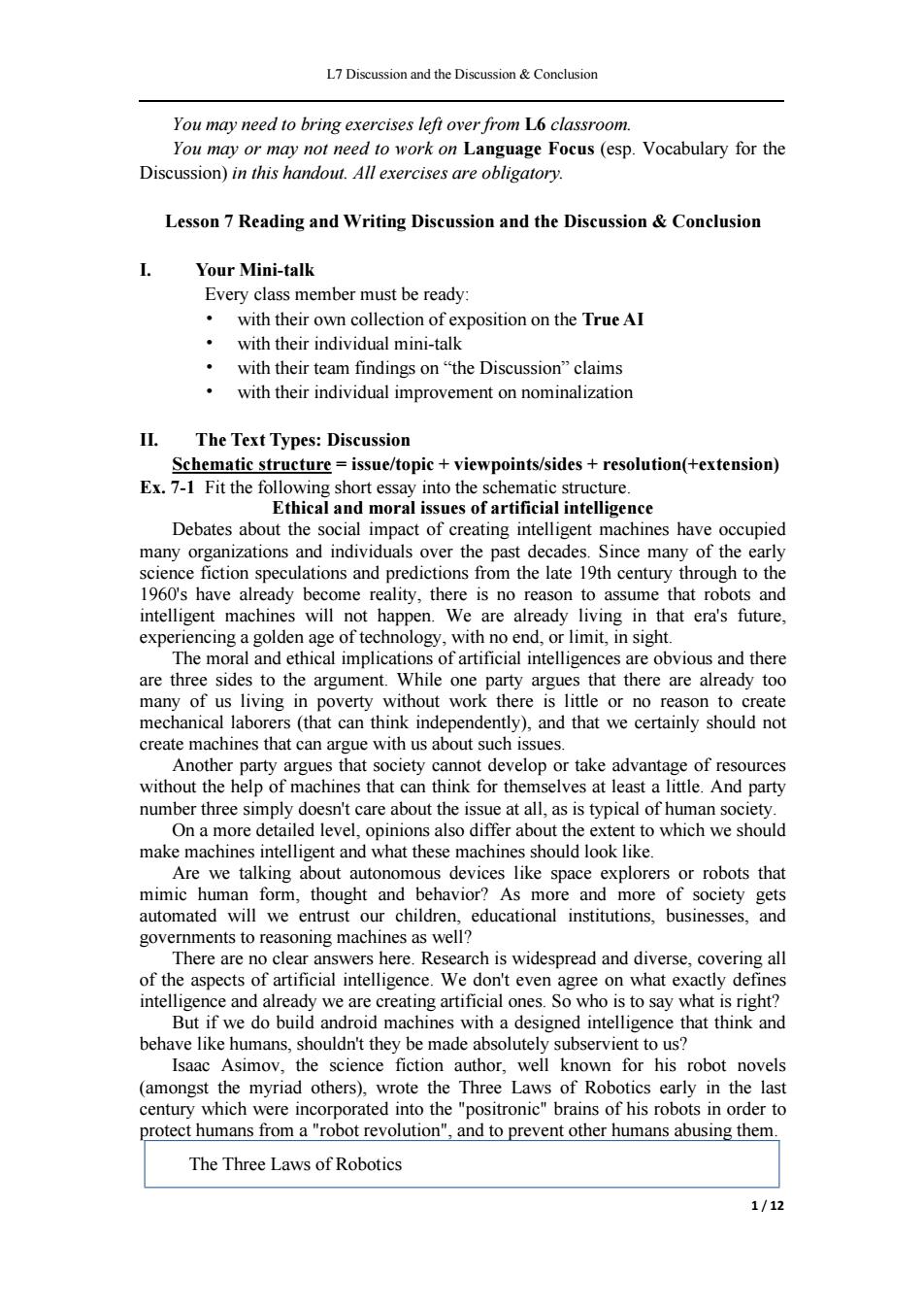
L7 Discussion and the Discussion Conclusion You may need to bring exercises left over from L6 classroom. You may or may not need to work on Language Focus (esp.Vocabulary for the Discussion)in this handout.All exercises are obligatory. Lesson 7 Reading and Writing Discussion and the Discussion Conclusion I. Your Mini-talk Every class member must be ready: with their own collection of exposition on the True AI with their individual mini-talk with their team findings on "the Discussion"claims with their individual improvement on nominalization II.The Text Types:Discussion Schematic structure issue/topic viewpoints/sides resolution(+extension) Ex.7-1 Fit the following short essay into the schematic structure. Ethical and moral issues of artificial intelligence Debates about the social impact of creating intelligent machines have occupied many organizations and individuals over the past decades.Since many of the early science fiction speculations and predictions from the late 19th century through to the 1960's have already become reality,there is no reason to assume that robots and intelligent machines will not happen.We are already living in that era's future, experiencing a golden age of technology,with no end,or limit,in sight. The moral and ethical implications of artificial intelligences are obvious and there are three sides to the argument.While one party argues that there are already too many of us living in poverty without work there is little or no reason to create mechanical laborers(that can think independently),and that we certainly should not create machines that can argue with us about such issues. Another party argues that society cannot develop or take advantage of resources without the help of machines that can think for themselves at least a little.And party number three simply doesn't care about the issue at all,as is typical of human society. On a more detailed level,opinions also differ about the extent to which we should make machines intelligent and what these machines should look like. Are we talking about autonomous devices like space explorers or robots that mimic human form,thought and behavior?As more and more of society gets automated will we entrust our children,educational institutions,businesses,and governments to reasoning machines as well? There are no clear answers here.Research is widespread and diverse,covering all of the aspects of artificial intelligence.We don't even agree on what exactly defines intelligence and already we are creating artificial ones.So who is to say what is right? But if we do build android machines with a designed intelligence that think and behave like humans,shouldn't they be made absolutely subservient to us? Isaac Asimov,the science fiction author,well known for his robot novels (amongst the myriad others),wrote the Three Laws of Robotics early in the last century which were incorporated into the "positronic"brains of his robots in order to protect humans from a"robot revolution",and to prevent other humans abusing them. The Three Laws of Robotics 1/12
L7 Discussion and the Discussion & Conclusion 1 / 12 You may need to bring exercises left over from L6 classroom. You may or may not need to work on Language Focus (esp. Vocabulary for the Discussion) in this handout. All exercises are obligatory. Lesson 7 Reading and Writing Discussion and the Discussion & Conclusion I. Your Mini-talk Every class member must be ready: • with their own collection of exposition on the True AI • with their individual mini-talk • with their team findings on “the Discussion” claims • with their individual improvement on nominalization II. The Text Types: Discussion Schematic structure = issue/topic + viewpoints/sides + resolution(+extension) Ex. 7-1 Fit the following short essay into the schematic structure. Ethical and moral issues of artificial intelligence Debates about the social impact of creating intelligent machines have occupied many organizations and individuals over the past decades. Since many of the early science fiction speculations and predictions from the late 19th century through to the 1960's have already become reality, there is no reason to assume that robots and intelligent machines will not happen. We are already living in that era's future, experiencing a golden age of technology, with no end, or limit, in sight. The moral and ethical implications of artificial intelligences are obvious and there are three sides to the argument. While one party argues that there are already too many of us living in poverty without work there is little or no reason to create mechanical laborers (that can think independently), and that we certainly should not create machines that can argue with us about such issues. Another party argues that society cannot develop or take advantage of resources without the help of machines that can think for themselves at least a little. And party number three simply doesn't care about the issue at all, as is typical of human society. On a more detailed level, opinions also differ about the extent to which we should make machines intelligent and what these machines should look like. Are we talking about autonomous devices like space explorers or robots that mimic human form, thought and behavior? As more and more of society gets automated will we entrust our children, educational institutions, businesses, and governments to reasoning machines as well? There are no clear answers here. Research is widespread and diverse, covering all of the aspects of artificial intelligence. We don't even agree on what exactly defines intelligence and already we are creating artificial ones. So who is to say what is right? But if we do build android machines with a designed intelligence that think and behave like humans, shouldn't they be made absolutely subservient to us? Isaac Asimov, the science fiction author, well known for his robot novels (amongst the myriad others), wrote the Three Laws of Robotics early in the last century which were incorporated into the "positronic" brains of his robots in order to protect humans from a "robot revolution", and to prevent other humans abusing them. The Three Laws of Robotics
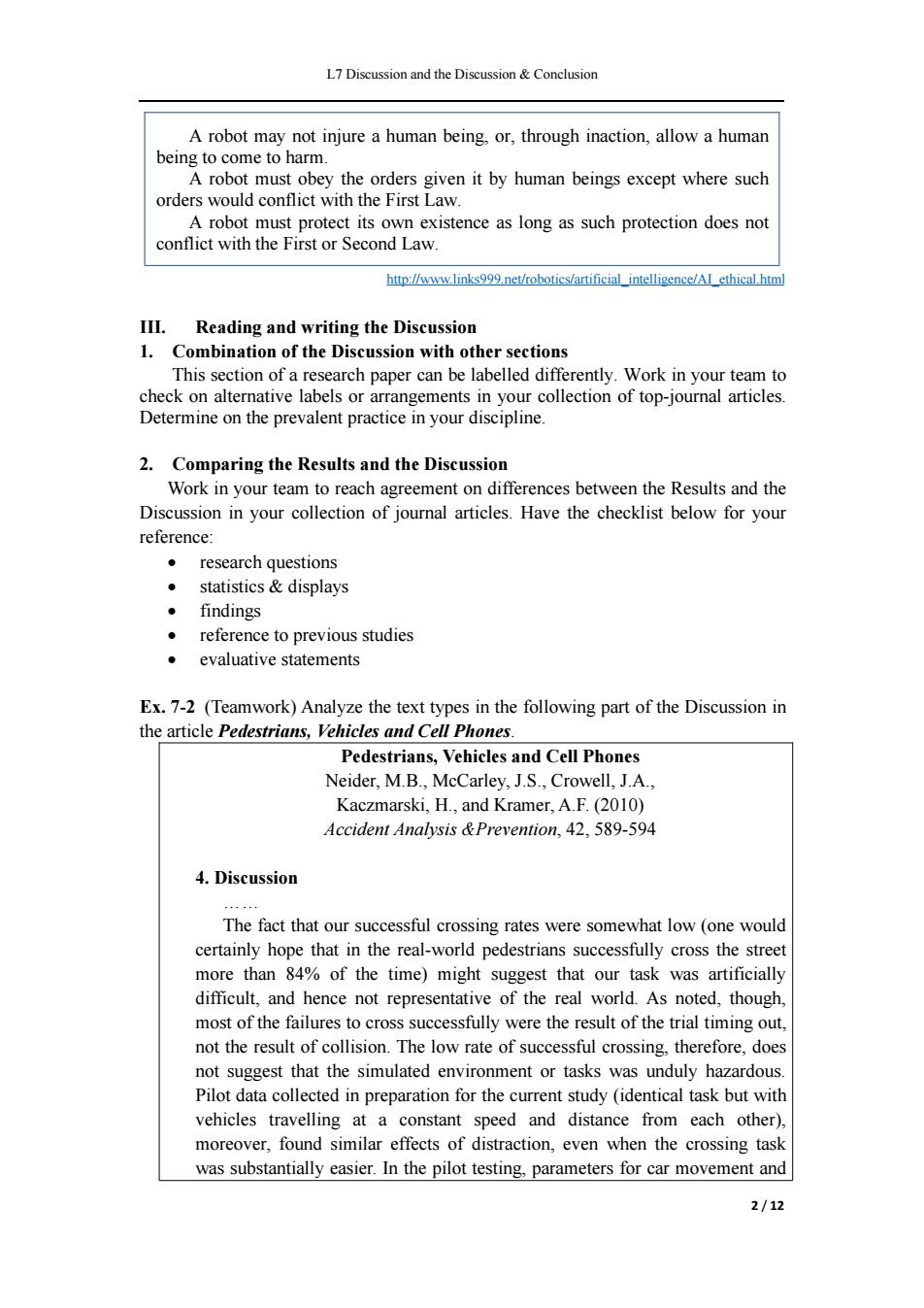
L7 Discussion and the Discussion Conclusion A robot may not injure a human being,or,through inaction,allow a human being to come to harm. A robot must obey the orders given it by human beings except where such orders would conflict with the First Law. A robot must protect its own existence as long as such protection does not conflict with the First or Second Law. http://www.links999.net/robotics/artificial intelligence/AI ethical.html III.Reading and writing the Discussion 1.Combination of the Discussion with other sections This section of a research paper can be labelled differently.Work in your team to check on alternative labels or arrangements in your collection of top-journal articles. Determine on the prevalent practice in your discipline. 2.Comparing the Results and the Discussion Work in your team to reach agreement on differences between the Results and the Discussion in your collection of journal articles.Have the checklist below for your reference: research questions ● statistics displays ● findings reference to previous studies evaluative statements Ex.7-2 (Teamwork)Analyze the text types in the following part of the Discussion in the article Pedestrians,Vehicles and Cell Phones. Pedestrians,Vehicles and Cell Phones Neider,M.B.,McCarley,J.S.,Crowell,J.A. Kaczmarski,H.,and Kramer,A.F.(2010) Accident Analysis &Prevention,42,589-594 4.Discussion 。。。 The fact that our successful crossing rates were somewhat low (one would certainly hope that in the real-world pedestrians successfully cross the street more than 84%of the time)might suggest that our task was artificially difficult,and hence not representative of the real world.As noted,though most of the failures to cross successfully were the result of the trial timing out, not the result of collision.The low rate of successful crossing,therefore,does not suggest that the simulated environment or tasks was unduly hazardous. Pilot data collected in preparation for the current study(identical task but with vehicles travelling at a constant speed and distance from each other), moreover,found similar effects of distraction,even when the crossing task was substantially easier.In the pilot testing,parameters for car movement and 2/12
L7 Discussion and the Discussion & Conclusion 2 / 12 A robot may not injure a human being, or, through inaction, allow a human being to come to harm. A robot must obey the orders given it by human beings except where such orders would conflict with the First Law. A robot must protect its own existence as long as such protection does not conflict with the First or Second Law. http://www.links999.net/robotics/artificial_intelligence/AI_ethical.html III. Reading and writing the Discussion 1. Combination of the Discussion with other sections This section of a research paper can be labelled differently. Work in your team to check on alternative labels or arrangements in your collection of top-journal articles. Determine on the prevalent practice in your discipline. 2. Comparing the Results and the Discussion Work in your team to reach agreement on differences between the Results and the Discussion in your collection of journal articles. Have the checklist below for your reference: research questions statistics & displays findings reference to previous studies evaluative statements Ex. 7-2 (Teamwork) Analyze the text types in the following part of the Discussion in the article Pedestrians, Vehicles and Cell Phones. Pedestrians, Vehicles and Cell Phones Neider, M.B., McCarley, J.S., Crowell, J.A., Kaczmarski, H., and Kramer, A.F. (2010) Accident Analysis &Prevention, 42, 589-594 4. Discussion …… The fact that our successful crossing rates were somewhat low (one would certainly hope that in the real-world pedestrians successfully cross the street more than 84% of the time) might suggest that our task was artificially difficult, and hence not representative of the real world. As noted, though, most of the failures to cross successfully were the result of the trial timing out, not the result of collision. The low rate of successful crossing, therefore, does not suggest that the simulated environment or tasks was unduly hazardous. Pilot data collected in preparation for the current study (identical task but with vehicles travelling at a constant speed and distance from each other), moreover, found similar effects of distraction, even when the crossing task was substantially easier. In the pilot testing, parameters for car movement and
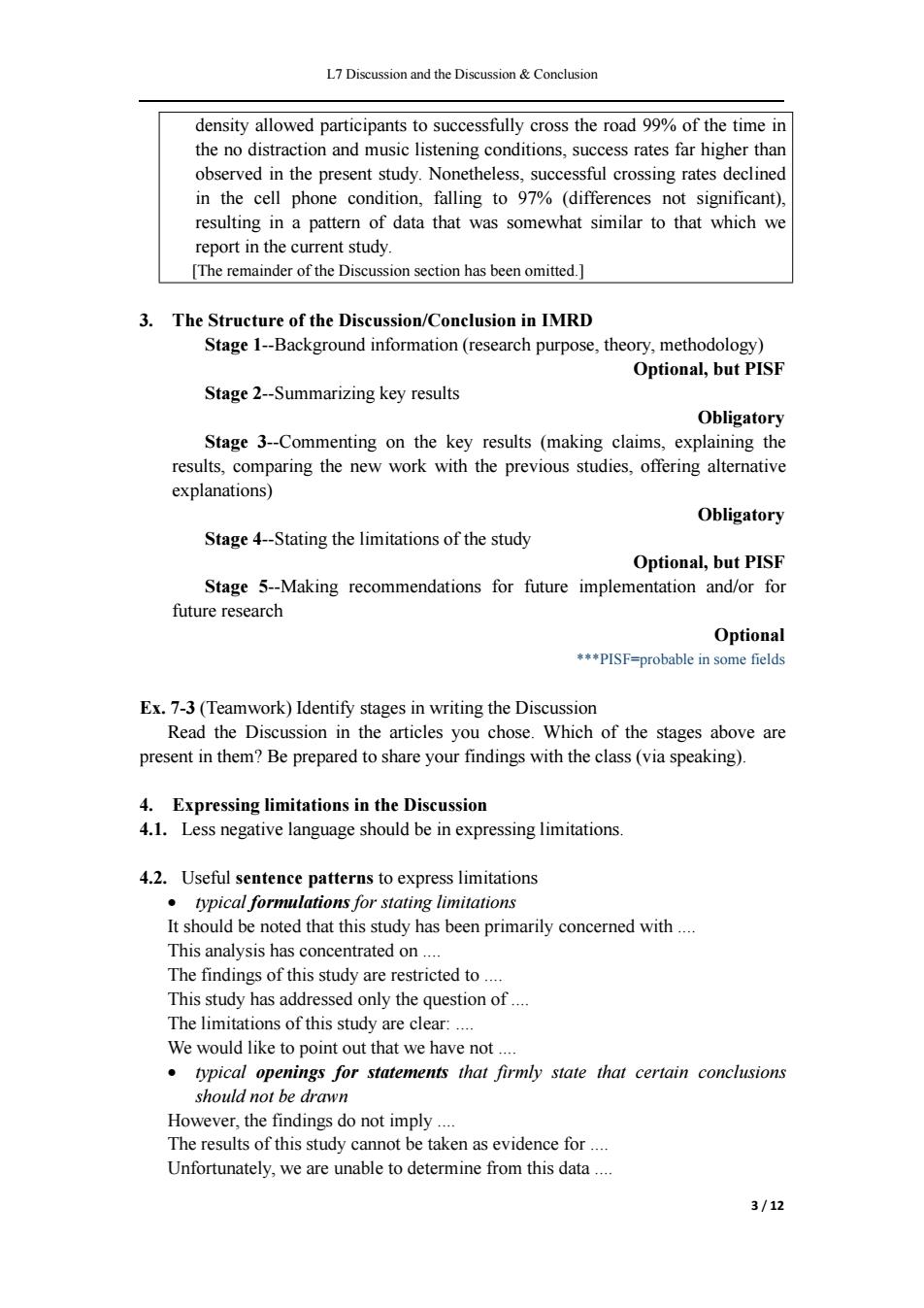
L7 Discussion and the Discussion Conclusion density allowed participants to successfully cross the road 99%of the time in the no distraction and music listening conditions,success rates far higher than observed in the present study.Nonetheless,successful crossing rates declined in the cell phone condition,falling to 97%(differences not significant), resulting in a pattern of data that was somewhat similar to that which we report in the current study. [The remainder of the Discussion section has been omitted.] 3.The Structure of the Discussion/Conclusion in IMRD Stage 1--Background information(research purpose,theory,methodology) Optional,but PISF Stage 2--Summarizing key results Obligatory Stage 3--Commenting on the key results (making claims,explaining the results,comparing the new work with the previous studies,offering alternative explanations) Obligatory Stage 4--Stating the limitations of the study Optional,but PISF Stage 5--Making recommendations for future implementation and/or for future research Optional ***PISF=probable in some fields Ex.7-3(Teamwork)Identify stages in writing the Discussion Read the Discussion in the articles you chose.Which of the stages above are present in them?Be prepared to share your findings with the class(via speaking). 4.Expressing limitations in the Discussion 4.1.Less negative language should be in expressing limitations. 4.2.Useful sentence patterns to express limitations typical formulations for stating limitations It should be noted that this study has been primarily concerned with.... This analysis has concentrated on.... The findings of this study are restricted to.... This study has addressed only the question of.... The limitations of this study are clear:.... We would like to point out that we have not.... typical openings for statements that firmly state that certain conclusions should not be drawn However,the findings do not imply.... The results of this study cannot be taken as evidence for.... Unfortunately,we are unable to determine from this data.... 3/12
L7 Discussion and the Discussion & Conclusion 3 / 12 density allowed participants to successfully cross the road 99% of the time in the no distraction and music listening conditions, success rates far higher than observed in the present study. Nonetheless, successful crossing rates declined in the cell phone condition, falling to 97% (differences not significant), resulting in a pattern of data that was somewhat similar to that which we report in the current study. [The remainder of the Discussion section has been omitted.] 3. The Structure of the Discussion/Conclusion in IMRD Stage 1--Background information (research purpose, theory, methodology) Optional, but PISF Stage 2--Summarizing key results Obligatory Stage 3--Commenting on the key results (making claims, explaining the results, comparing the new work with the previous studies, offering alternative explanations) Obligatory Stage 4--Stating the limitations of the study Optional, but PISF Stage 5--Making recommendations for future implementation and/or for future research Optional ***PISF=probable in some fields Ex. 7-3 (Teamwork) Identify stages in writing the Discussion Read the Discussion in the articles you chose. Which of the stages above are present in them? Be prepared to share your findings with the class (via speaking). 4. Expressing limitations in the Discussion 4.1. Less negative language should be in expressing limitations. 4.2. Useful sentence patterns to express limitations typical formulations for stating limitations It should be noted that this study has been primarily concerned with .... This analysis has concentrated on .... The findings of this study are restricted to .... This study has addressed only the question of .... The limitations of this study are clear: .... We would like to point out that we have not .... typical openings for statements that firmly state that certain conclusions should not be drawn However, the findings do not imply .... The results of this study cannot be taken as evidence for .... Unfortunately, we are unable to determine from this data
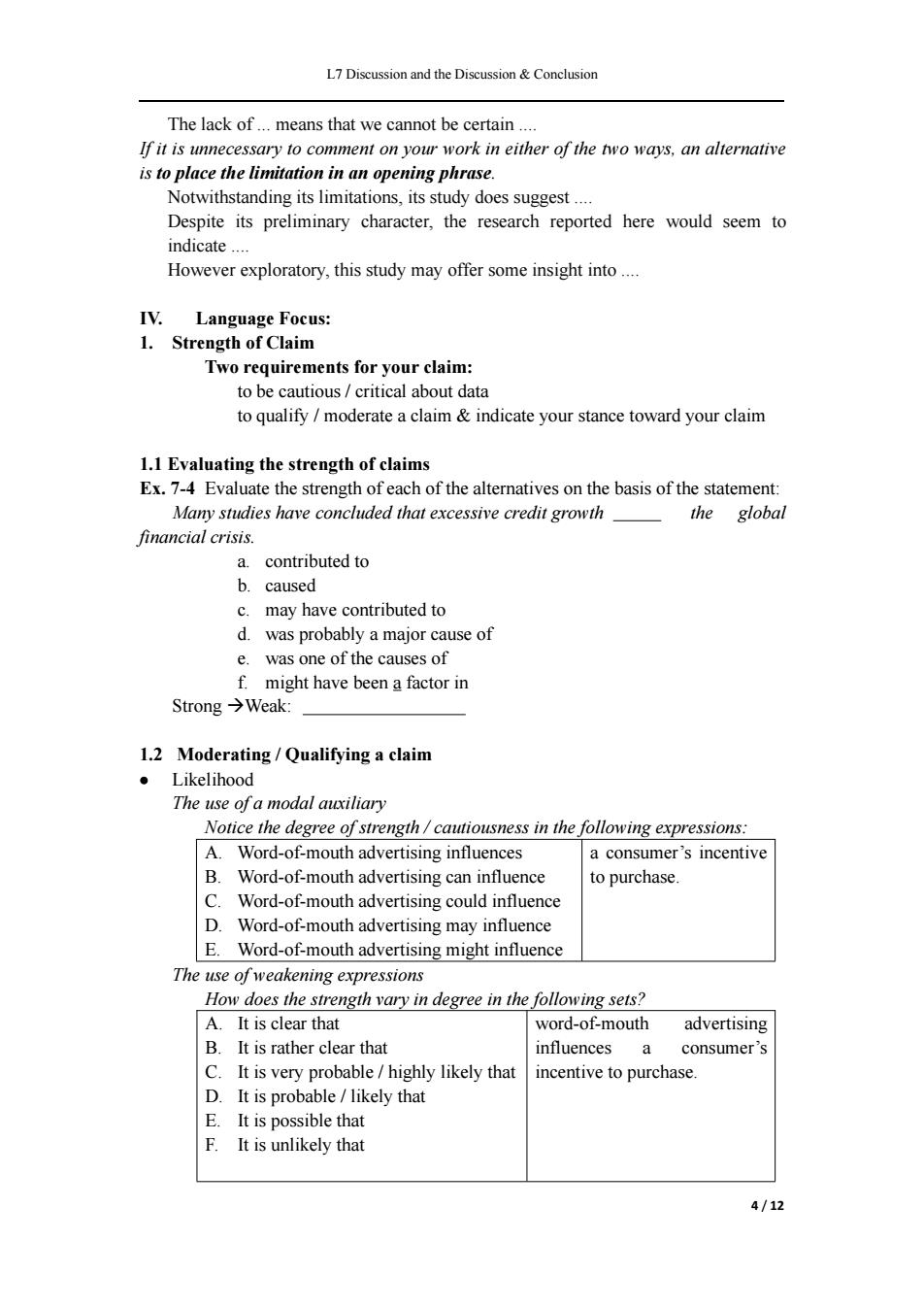
L7 Discussion and the Discussion Conclusion The lack of...means that we cannot be certain.... If it is unnecessary to comment on your work in either of the two ways,an alternative is to place the limitation in an opening phrase. Notwithstanding its limitations,its study does suggest... Despite its preliminary character,the research reported here would seem to indicate… However exploratory,this study may offer some insight into.... IV.Language Focus: 1.Strength of Claim Two requirements for your claim: to be cautious critical about data to qualify moderate a claim indicate your stance toward your claim 1.1 Evaluating the strength of claims Ex.7-4 Evaluate the strength of each of the alternatives on the basis of the statement: Many studies have concluded that excessive credit growth the global financial crisis a.contributed to b.caused c.may have contributed to d.was probably a major cause of e.was one of the causes of f.might have been a factor in Strong→Weak: 1.2 Moderating/Qualifying a claim 。Likelihood The use of a modal auxiliary Notice the degree of strength cautiousness in the following expressions: A.Word-of-mouth advertising influences a consumer's incentive B. Word-of-mouth advertising can influence to purchase. C. Word-of-mouth advertising could influence D. Word-of-mouth advertising may influence E.Word-of-mouth advertising might influence The use ofweakening expressions How does the strength vary in degree in the following sets? A.It is clear that word-of-mouth advertising B.It is rather clear that influences a consumer's C.It is very probable/highly likely that incentive to purchase. D.It is probable/likely that E. It is possible that F.It is unlikely that 4/12
L7 Discussion and the Discussion & Conclusion 4 / 12 The lack of ... means that we cannot be certain .... If it is unnecessary to comment on your work in either of the two ways, an alternative is to place the limitation in an opening phrase. Notwithstanding its limitations, its study does suggest .... Despite its preliminary character, the research reported here would seem to indicate .... However exploratory, this study may offer some insight into .... IV. Language Focus: 1. Strength of Claim Two requirements for your claim: to be cautious / critical about data to qualify / moderate a claim & indicate your stance toward your claim 1.1 Evaluating the strength of claims Ex. 7-4 Evaluate the strength of each of the alternatives on the basis of the statement: Many studies have concluded that excessive credit growth the global financial crisis. a. contributed to b. caused c. may have contributed to d. was probably a major cause of e. was one of the causes of f. might have been a factor in Strong Weak: 1.2 Moderating / Qualifying a claim Likelihood The use of a modal auxiliary Notice the degree of strength / cautiousness in the following expressions: A. Word-of-mouth advertising influences B. Word-of-mouth advertising can influence C. Word-of-mouth advertising could influence D. Word-of-mouth advertising may influence E. Word-of-mouth advertising might influence a consumer’s incentive to purchase. The use of weakening expressions How does the strength vary in degree in the following sets? A. It is clear that B. It is rather clear that C. It is very probable / highly likely that D. It is probable / likely that E. It is possible that F. It is unlikely that word-of-mouth advertising influences a consumer’s incentive to purchase
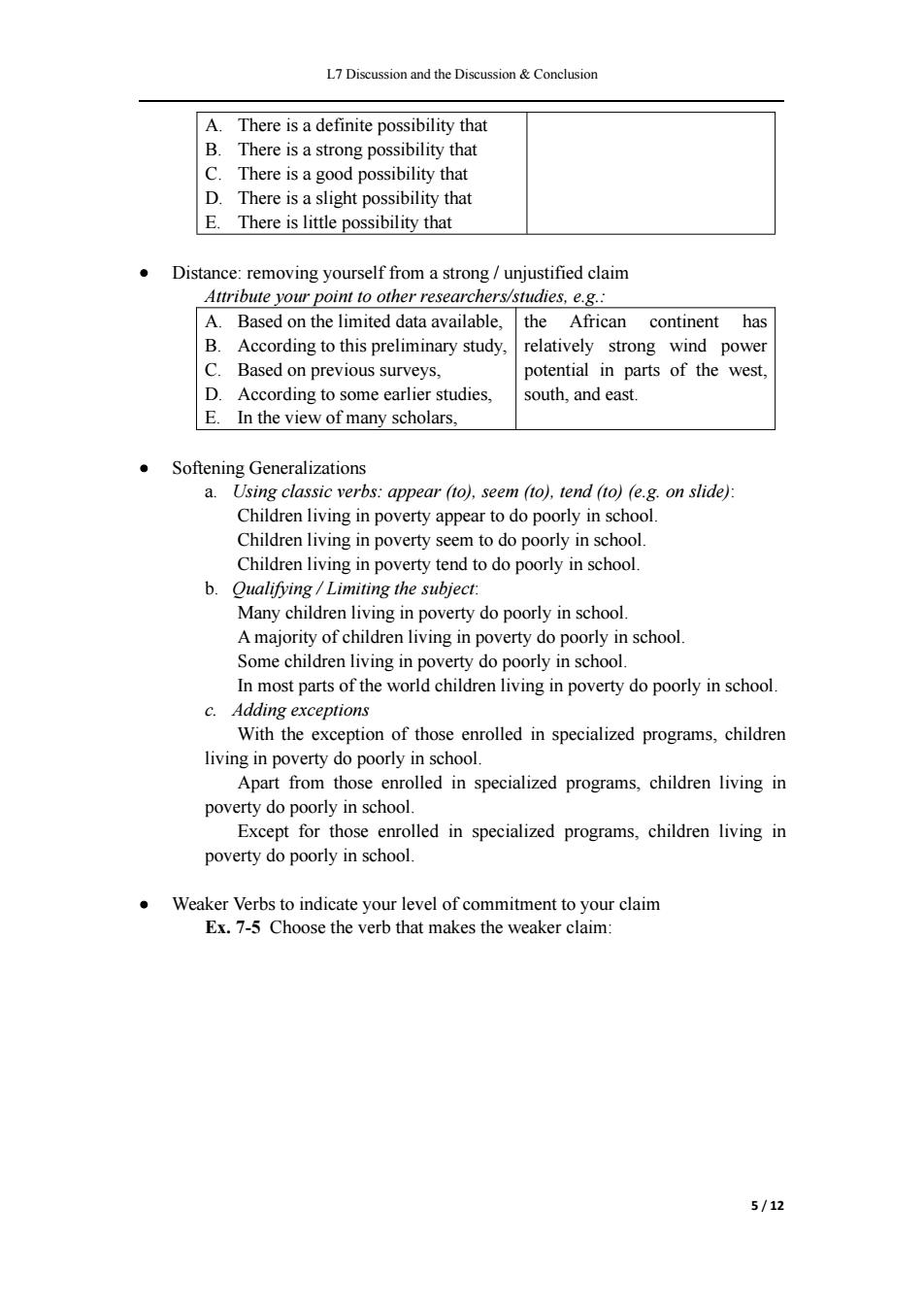
L7 Discussion and the Discussion Conclusion A There is a definite possibility that B.There is a strong possibility that C. There is a good possibility that D.There is a slight possibility that E.There is little possibility that Distance:removing yourself from a strong/unjustified claim Attribute your point to other researchers/studies,e.g.: A.Based on the limited data available, the African continent has B.According to this preliminary study, relatively strong wind power C. Based on previous surveys, potential in parts of the west, D. According to some earlier studies, south,and east. E.In the view of many scholars, ● Softening Generalizations a. Using classic verbs:appear (to),seem (to),tend (to)(e.g.on slide): Children living in poverty appear to do poorly in school. Children living in poverty seem to do poorly in school. Children living in poverty tend to do poorly in school. b.Qualifying Limiting the subject: Many children living in poverty do poorly in school A majority of children living in poverty do poorly in school. Some children living in poverty do poorly in school. In most parts of the world children living in poverty do poorly in school. c.Adding exceptions With the exception of those enrolled in specialized programs,children living in poverty do poorly in school. Apart from those enrolled in specialized programs,children living in poverty do poorly in school. Except for those enrolled in specialized programs,children living in poverty do poorly in school. Weaker Verbs to indicate your level of commitment to your claim Ex.7-5 Choose the verb that makes the weaker claim: 5/12
L7 Discussion and the Discussion & Conclusion 5 / 12 A. There is a definite possibility that B. There is a strong possibility that C. There is a good possibility that D. There is a slight possibility that E. There is little possibility that Distance: removing yourself from a strong / unjustified claim Attribute your point to other researchers/studies, e.g.: A. Based on the limited data available, B. According to this preliminary study, C. Based on previous surveys, D. According to some earlier studies, E. In the view of many scholars, the African continent has relatively strong wind power potential in parts of the west, south, and east. Softening Generalizations a. Using classic verbs: appear (to), seem (to), tend (to) (e.g. on slide): Children living in poverty appear to do poorly in school. Children living in poverty seem to do poorly in school. Children living in poverty tend to do poorly in school. b. Qualifying / Limiting the subject: Many children living in poverty do poorly in school. A majority of children living in poverty do poorly in school. Some children living in poverty do poorly in school. In most parts of the world children living in poverty do poorly in school. c. Adding exceptions With the exception of those enrolled in specialized programs, children living in poverty do poorly in school. Apart from those enrolled in specialized programs, children living in poverty do poorly in school. Except for those enrolled in specialized programs, children living in poverty do poorly in school. Weaker Verbs to indicate your level of commitment to your claim Ex. 7-5 Choose the verb that makes the weaker claim:

L7 Discussion and the Discussion Conclusion 1.The results (indicate establish)that there is a link between smoking and lung cancer. 2.The survey results (suggest/show)that the reuse of sentences or sections from one's previously published papers is a ques- tionable practice. 3.The latest series of studies(question /challenge)the value of including consumer expectations in the assessment of service quality. 4.The results given in Figure 4(validate support)the second conclusion that certain bacteria can reduce arsenic (As)levels in groundwater. 5.Baseline conditions have been (assumed shown)to be accurate at the time of the surveys. 6.Several studies have (identified alluded to)the importance of cultural sensitivity as a precursor to culturally appropriate medical care 7.Changes in ambient temperature may have (influenced/ distorted)the test results. 8.Previous studies(failed forgot)to consider the change in the fiber interface during the cracking process. 9.As shown in Figure 3,trade liberalization has (stimulated/ encouraged)economic growth in developing countries, leading to rising incomes. 10.Figure 12 (depicts/clarifies)the relationship between these two systems. ● Combined Qualifications to be "confidently uncertain" Ex.7-6 Examine the strong claim:When people have too many choices,they choose the safest one.Try to add distance,then weaken the generalization,and then indicate likelihood. Ex.7-7 Soften the claims and make the statements academically respectable and defensible. 1.Tall people have higher incomes than short people. 2.Economic sanctions are ineffective. 3.Alcohol causes brain damage in teenagers. 4.Passive smoking causes cancer. 5.Recycling is the best solution to the waste disposal problem. 6.Physical exercise prevents depression. 7.Deep tunnels are safer and less vulnerable to earthquake shaking than are shallow tunnels. 8.Private schools provide a better education than do public schools. 2.Vocabulary for the Discussion Mapping(relationship to existing research) 6/12
L7 Discussion and the Discussion & Conclusion 6 / 12 Combined Qualifications to be “confidently uncertain” Ex. 7-6 Examine the strong claim: When people have too many choices, they choose the safest one. Try to add distance, then weaken the generalization, and then indicate likelihood. Ex. 7-7 Soften the claims and make the statements academically respectable and defensible. 2. Vocabulary for the Discussion Mapping (relationship to existing research)
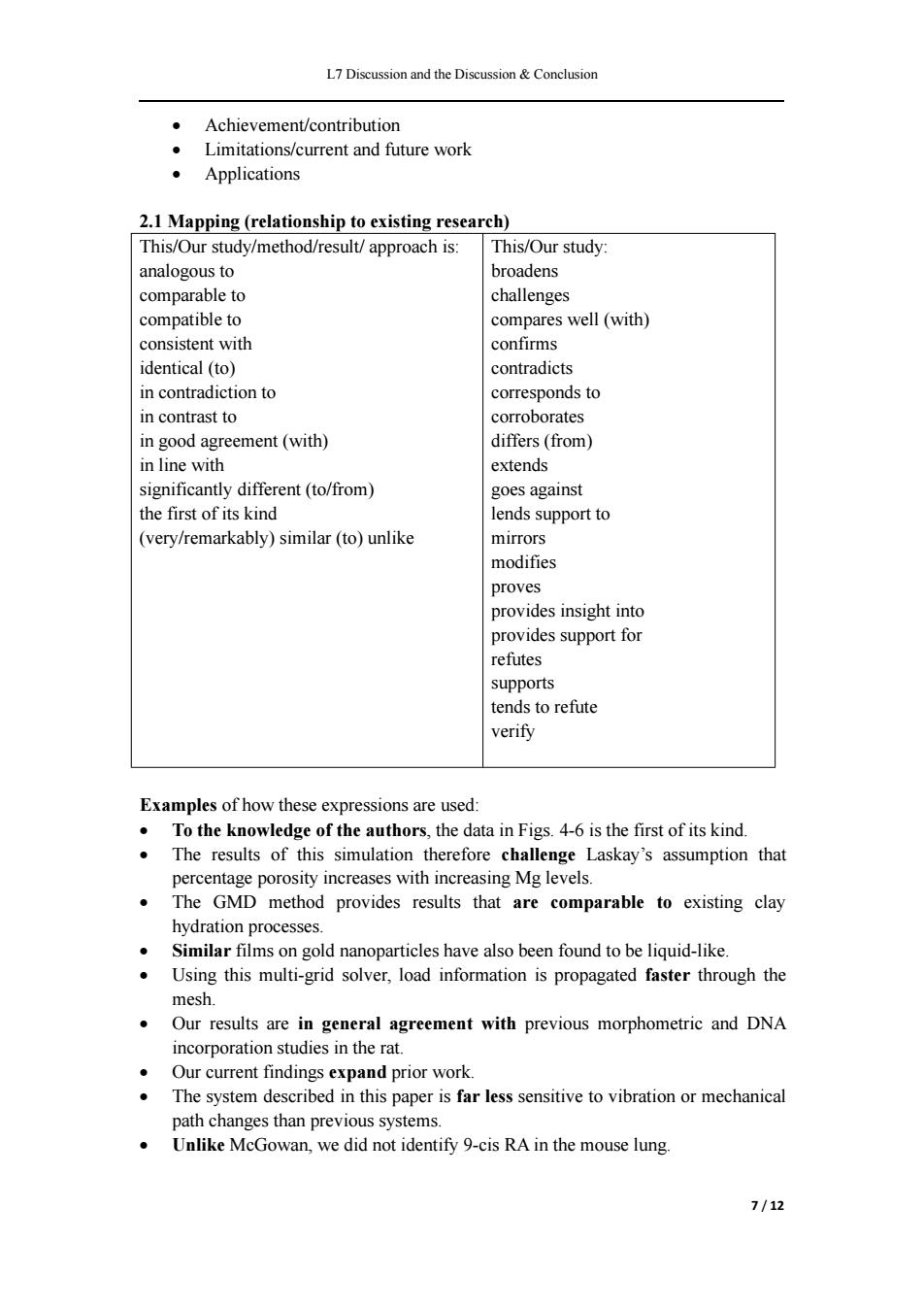
L7 Discussion and the Discussion Conclusion Achievement/contribution Limitations/current and future work ·Applications 2.1 Mapping(relationship to existing research) This/Our study/method/result/approach is: This/Our study: analogous to broadens comparable to challenges compatible to compares well(with) consistent with confirms identical (to) contradicts in contradiction to corresponds to in contrast to corroborates in good agreement(with) differs(from) in line with extends significantly different(to/from) goes against the first of its kind lends support to (very/remarkably)similar(to)unlike mirrors modifies proves provides insight into provides support for refutes supports tends to refute verify Examples of how these expressions are used: To the knowledge of the authors,the data in Figs.4-6 is the first of its kind. The results of this simulation therefore challenge Laskay's assumption that percentage porosity increases with increasing Mg levels. The GMD method provides results that are comparable to existing clay hydration processes. Similar films on gold nanoparticles have also been found to be liquid-like Using this multi-grid solver,load information is propagated faster through the mesh. Our results are in general agreement with previous morphometric and DNA incorporation studies in the rat. Our current findings expand prior work. The system described in this paper is far less sensitive to vibration or mechanical path changes than previous systems. ● Unlike McGowan,we did not identify 9-cis RA in the mouse lung. 7/12
L7 Discussion and the Discussion & Conclusion 7 / 12 Achievement/contribution Limitations/current and future work Applications 2.1 Mapping (relationship to existing research) This/Our study/method/result/ approach is: analogous to comparable to compatible to consistent with identical (to) in contradiction to in contrast to in good agreement (with) in line with significantly different (to/from) the first of its kind (very/remarkably) similar (to) unlike This/Our study: broadens challenges compares well (with) confirms contradicts corresponds to corroborates differs (from) extends goes against lends support to mirrors modifies proves provides insight into provides support for refutes supports tends to refute verify Examples of how these expressions are used: To the knowledge of the authors, the data in Figs. 4-6 is the first of its kind. The results of this simulation therefore challenge Laskay’s assumption that percentage porosity increases with increasing Mg levels. The GMD method provides results that are comparable to existing clay hydration processes. Similar films on gold nanoparticles have also been found to be liquid-like. Using this multi-grid solver, load information is propagated faster through the mesh. Our results are in general agreement with previous morphometric and DNA incorporation studies in the rat. Our current findings expand prior work. The system described in this paper is far less sensitive to vibration or mechanical path changes than previous systems. Unlike McGowan, we did not identify 9-cis RA in the mouse lung
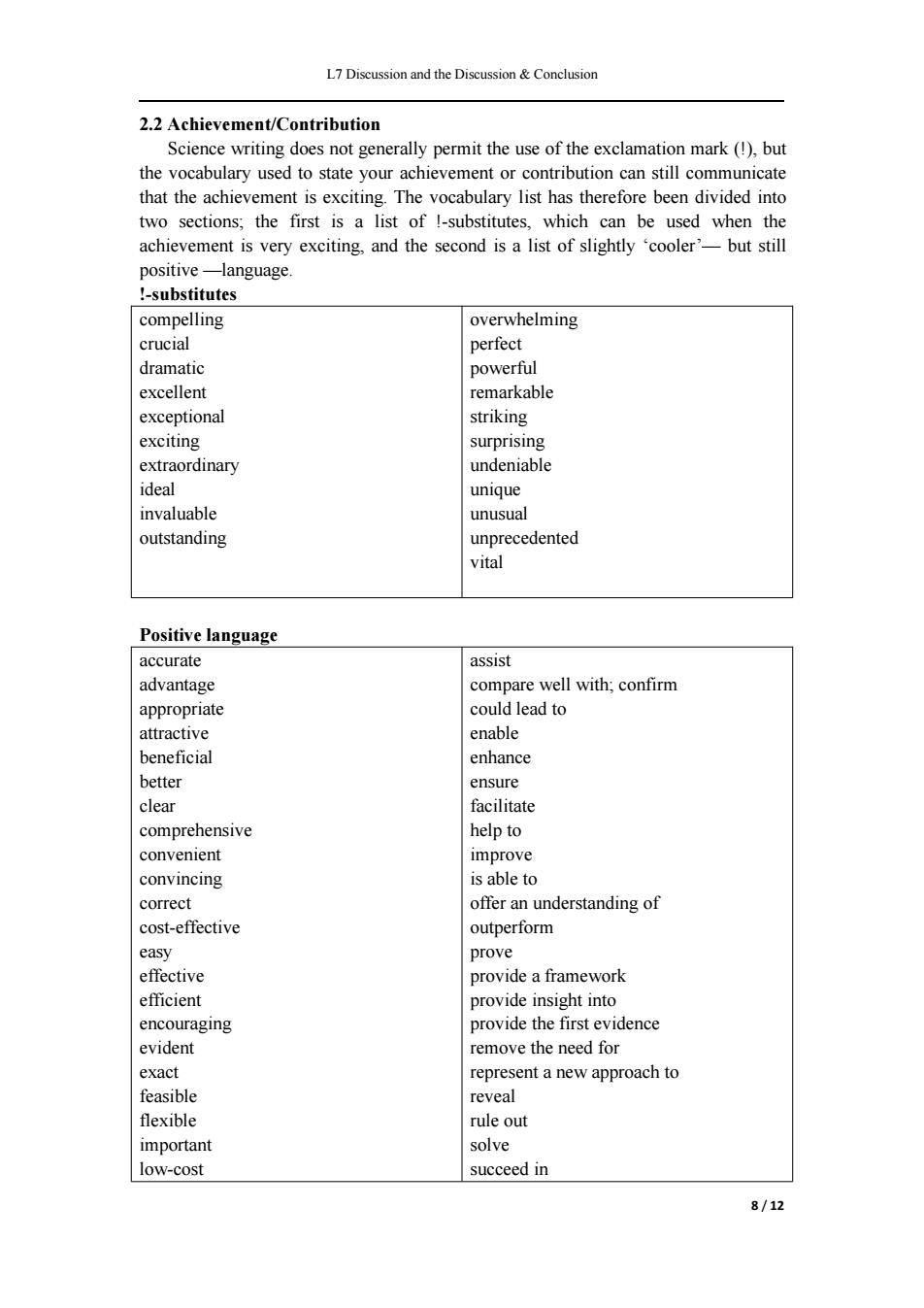
L7 Discussion and the Discussion Conclusion 2.2 Achievement/Contribution Science writing does not generally permit the use of the exclamation mark (!)but the vocabulary used to state your achievement or contribution can still communicate that the achievement is exciting.The vocabulary list has therefore been divided into two sections;the first is a list of !-substitutes,which can be used when the achievement is very exciting,and the second is a list of slightly cooler'-but still positive-language. !-substitutes compelling overwhelming crucial perfect dramatic powerful excellent remarkable exceptional striking exciting surprising extraordinary undeniable ideal unique invaluable unusual outstanding unprecedented vital Positive language accurate assist advantage compare well with;confirm appropriate could lead to attractive enable beneficial enhance better ensure clear facilitate comprehensive help to convenient improve convincing is able to correct offer an understanding of cost-effective outperform easy prove effective provide a framework efficient provide insight into encouraging provide the first evidence evident remove the need for exact represent a new approach to feasible reveal flexible rule out important solve low-cost succeed in 8/12
L7 Discussion and the Discussion & Conclusion 8 / 12 2.2 Achievement/Contribution Science writing does not generally permit the use of the exclamation mark (!), but the vocabulary used to state your achievement or contribution can still communicate that the achievement is exciting. The vocabulary list has therefore been divided into two sections; the first is a list of !-substitutes, which can be used when the achievement is very exciting, and the second is a list of slightly ‘cooler’— but still positive —language. !-substitutes compelling crucial dramatic excellent exceptional exciting extraordinary ideal invaluable outstanding overwhelming perfect powerful remarkable striking surprising undeniable unique unusual unprecedented vital Positive language accurate advantage appropriate attractive beneficial better clear comprehensive convenient convincing correct cost-effective easy effective efficient encouraging evident exact feasible flexible important low-cost assist compare well with; confirm could lead to enable enhance ensure facilitate help to improve is able to offer an understanding of outperform prove provide a framework provide insight into provide the first evidence remove the need for represent a new approach to reveal rule out solve succeed in

L7 Discussion and the Discussion Conclusion novel support productive yield realistic relevant robust simple stable straightforward strong successful superior undeniable useful valid valuable Examples of how these expressions are used: The presence of such high levels is a novel finding. We identify dramatically different provides in adult lungs. Our results provide compelling evidence that this facilitated infection. These preliminary results demonstrate the feasibility of using hologram-based RI detectors. Our data rule out the possibility that this behavior was a result of neurological abnormality. The system presented here is a cost-effective detection protocol. A straightforward analysis procedure was presented which enables the accurate prediction of column behavior. Our study provides the framework for future studies to assess the performance characteristics. We have made the surprising observation that Brol-GFP focus accumulation is also pH-dependent. We have derived exact analytic expressions for the percolation threshold. Our results provide a clear distinction between the functions of the pathway proteins. 2.3 Limitations/Current and future research You will normally outline the limitations of your own work,but this is not expressed as a problem with your work,rather it provides suggestions for future work. This invitation to the research community improves the status of your work by communicating that there is much research to be done in this area. Note that using will or the Present Continuous (e.g.we will integrate/we are integrating this technique with the FEM implementations)communicates your own intentions or work in progress;should is used to invite research from others (This technique should be integrated with the FEM implementations). a/the need for possible direction 9/12
L7 Discussion and the Discussion & Conclusion 9 / 12 novel productive realistic relevant robust simple stable straightforward strong successful superior undeniable useful valid valuable support yield Examples of how these expressions are used: The presence of such high levels is a novel finding. We identify dramatically different provides in adult lungs. Our results provide compelling evidence that this facilitated infection. These preliminary results demonstrate the feasibility of using hologram-based RI detectors. Our data rule out the possibility that this behavior was a result of neurological abnormality. The system presented here is a cost-effective detection protocol. A straightforward analysis procedure was presented which enables the accurate prediction of column behavior. Our study provides the framework for future studies to assess the performance characteristics. We have made the surprising observation that Bro1-GFP focus accumulation is also pH –dependent. We have derived exact analytic expressions for the percolation threshold. Our results provide a clear distinction between the functions of the pathway proteins. 2.3 Limitations/Current and future research You will normally outline the limitations of your own work, but this is not expressed as a problem with your work, rather it provides suggestions for future work. This invitation to the research community improves the status of your work by communicating that there is much research to be done in this area. Note that using will or the Present Continuous (e.g. we will integrate/we are integrating this technique with the FEM implementations) communicates your own intentions or work in progress; should is used to invite research from others (This technique should be integrated with the FEM implementations). a/the need for possible direction

L7 Discussion and the Discussion Conclusion at present promising encouraging recommend fruitful remain to be (identified) further investigation research opportunities further work is needed should be explored further work is planned should be replicated future work/studies should should be validated future work/studies will should be verified in future,care should be taken starting point in future,it is advised that... the next stage holds promise urgent interesting worthwhile it would be beneficial/useful Examples of how these expressions are used: Our results are encouraging and should be validated in a larger cohort of women. However,the neural mechanisms underlying these effects remain to be determined. ● This finding is promising and should be explored with other eukaryotes. Future work should focus on the efficacy of ligands synthesized in the Long group. An important question for future studies is to determine the antidepressant effects of such drugs. 2.4 Applications/Applicability/Implementation Research work does not always have a clear application.However,in some cases, it is clear how the work can be used,particularly if your project has resulted in a device or product of some kind.In such cases,you should indicate possible applications or applicability,and in many cases this can be derived from points made earlier in the Introduction.Don't forget to use modal verbs such as could,should and may. Eventually Apply In future Have potential Soon Implement possible Lead to Produce Use Utilize Examples of how these expressions are used: Our technique can be applied to a wide range of simulation applications. The PARSEX reactor therefore could be used for the realistic testing of a wide range of control algorithms It should be possible,therefore,to integrate the HOE onto a microchip. This approach has potential in areas such as fluid density measurement. 10/12
L7 Discussion and the Discussion & Conclusion 10 / 12 at present encouraging fruitful further investigation further work is needed further work is planned future work/studies should future work/studies will in future, care should be taken in future, it is advised that… holds promise interesting it would be beneficial/useful promising recommend remain to be (identified) research opportunities should be explored should be replicated should be validated should be verified starting point the next stage urgent worthwhile Examples of how these expressions are used: Our results are encouraging and should be validated in a larger cohort of women. However, the neural mechanisms underlying these effects remain to be determined. This finding is promising and should be explored with other eukaryotes. Future work should focus on the efficacy of ligands synthesized in the Long group. An important question for future studies is to determine the antidepressant effects of such drugs. 2.4 Applications/Applicability/Implementation Research work does not always have a clear application. However, in some cases, it is clear how the work can be used, particularly if your project has resulted in a device or product of some kind. In such cases, you should indicate possible applications or applicability, and in many cases this can be derived from points made earlier in the Introduction. Don’t forget to use modal verbs such as could, should and may. Eventually In future Soon possible Apply Have potential Implement Lead to Produce Use Utilize Examples of how these expressions are used: Our technique can be applied to a wide range of simulation applications. The PARSEX reactor therefore could be used for the realistic testing of a wide range of control algorithms It should be possible, therefore, to integrate the HOE onto a microchip. This approach has potential in areas such as fluid density measurement